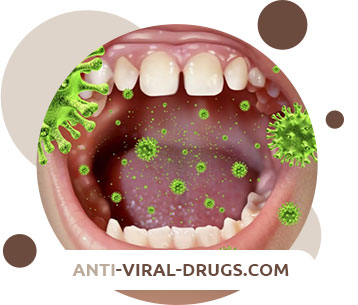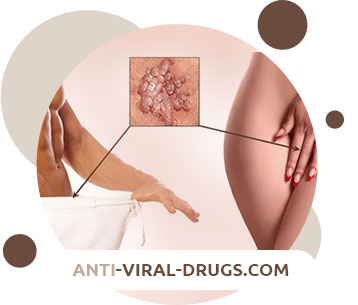

Viral diseases of the skin and mucous membranes
Herpes
This disease, most common in the population, is caused by two types of herpes simplex virus (HSV 1 and HSV). Primary, initial, recurrent and asymptomatic herpes simplex are distinguished.
The first manifestations of the disease can occur at any age, however, the so-called primary herpes is more often observed in children and young people 2-4 weeks after contact with the virus and is characterized by severe symptoms, due to the absence of specific (to the virus) antibodies.
The most characteristic are the acute onset of the viral process and a large number of rashes that occupy a large area. The picture of mucocutaneous lesions of all primary forms is accompanied by pronounced general phenomena - fever with a body temperature reaching 39-40 ° C, an increase and soreness of regional lymph nodes.
The main threat to life is the likelihood of dissemination of the pathogen during the development of a primary viral infection with damage to internal organs (central nervous system, liver, spleen, bronchi and lungs).
Initial herpes occurs in patients who have already had one type of herpes simplex and become infected with the second. In this case, the general effects of damage (severe general condition, fever, headache) are no longer so pronounced.
The clinical manifestations of relapse are usually even less pronounced.
The asymptomatic form is characterized by the absence of signs of the disease at all.
The clinical picture of the disease is determined by the stage of the process.
- Erythematous stage
First, a hyperemic (bright pink) spot appears - Vesicular stage
Against the background of an inflammatory focus (hyperemic spot), bubbles appear, which are located in groups - Cortical stage
Bubbles shrink into crusts - Clinical recovery stage
The crusts are rejected, and the stain gradually fades and disappears
Along with the above, the classic clinical form of the disease, there are atypical varieties of it:
- Disseminated herpes simplex (PH)
- Migratory form (PG)
- Hemorrhagic form (PG)
- Zosteriform variability (PG)
- Edematous form (PG)
- Herpes simplex with abortive course
Features of epidemiology
Infection of the population with the herpes simplex virus is approaching 100%.
According to some data, in 20-25% of cases, and according to others - in 60-70%, herpes infection manifests itself clinically (in other words, the presence of a virus in the body may not necessarily manifest itself, but an infected person can be dangerous in terms of the possibility of infection for others)
HSV has a selective ability to initially invade the cells of the epidermis and outer mucous membranes (that is, it enters the body through the skin and mucous membranes)
Transmission ways:
- airborne
- contact-household
- sexual
- transplacental
The ability for lifelong persistence (existence) of infection after primary infection
By localization, the forms of herpes infection are divided into:
- damage to the mucous membranes of the oral cavity;
- eye damage: conjunctivitis, keratitis, etc.
- skin lesions: lips, face, hands, buttocks, etc.
- genital herpes;
- damage to the nervous system;
- generalized herpes simplex: visceral form (pneumonia, hepatitis, disseminated form (viral sepsis)
Urogenital herpes
Urogenital herpes (UH) is a special case of HSV infection and is one of the most common sexually transmitted infections. UG differs from other diseases of this group by the lifelong carriage of the pathogen in the human body, which leads to the formation of recurrent forms of the disease.
The urgency of the problem of herpes infection lies in the ability of HSV to cause an immunodeficiency state, chronic inflammatory diseases of the genital organs, and to have a negative effect on the fertility of women and men.
Urogenital herpes is divided into the following forms:
- Primary genital herpes
Infection occurs through direct physical (genital, orogenital or genitorectal) contact with a patient or a virus carrier. Clinically, on the mucous membranes of the genital organs and adjacent areas of the skin, grouped blister rashes appear against the background of hyperemia. Then the vesicles are opened and the process proceeds according to the scenario of a common herpes infection (see above). Patients are worried about itching, burning, soreness in the area of the rash. The body temperature may also rise to 38 ° C, an increase and soreness of the inguinal lymph nodes. - Recurrent genital herpesRecurrent genital herpes is the most common disease of the genitourinary system. It is characterized by a chronic course, impaired sexual and reproductive functions of patients and high resistance to treatment. The localization of the lesion is determined by the place of penetration of the virus and most often it is the mucous membranes of the genital organs (foreskin, coronal groove, scaphoid fossa in men and labia, mucous membrane of the vagina, cervix, and anal region in women). The disease can occur against a background of low-grade fever, malaise and general weakness, pain in the inguinal lymph nodes (usually on one side). Opening of the vesicular elements is accompanied by itching, burning and soreness. The described symptoms may change under the influence of the treatment.
- Herpetic urethritis
У мужчин – боли, чувство жжения, жара, ползания мурашек по ходу мочеиспускательного канала, рези при мочеиспускании. Губки уретры гиперемированы и отечны. Может наблюдаться скудное отделяемое слизистого характера из уретры. У женщин – боли и рези в начале мочеиспускания, дизурические явления. Наружное отверстие уретры гиперемировано со скудным слизистым отделяемым. - Herpetic cystitis
- Herpes of the anal area and rectum
- Herpes of the upper genital tract
- Herpetic prostatitis
Herpes is especially dangerous during pregnancy:
- HSV can cause inflammatory diseases of the genitourinary organs, pathology of pregnancy, and infection of the fetus.
- The frequency of miscarriage in primary herpes is 54% in early pregnancy and 25% in late pregnancy.
- The virus can penetrate the fetus transplacentally, transcervically.
- Infection in the first trimester leads to the development of hydrocephalus in the fetus, heart defects, gastrointestinal tract and other organs. Infection in the II and III trimesters causes hepatosplenomegaly, anemia, jaundice, hypotrophy, pneumonia, meningoencephalitis, and sepsis in the fetus.
- The most dangerous for the fetus is the primary infection in the mother, since viruses actively multiply in cells with a high metabolism.
- The most severe lesions occur in the first 2 months of fetal development.
- The most severe lesions occur in the first 2 months of fetal development.
Prevention of HS for a healthy person consists in the observance of sexual hygiene, which consists in limiting the number of sexual partners, in using condoms.
Prevention of a patient with genital herpes should be aimed at preventing the development of complicated forms of infection, for which the patient must be able to timely recognize and stop the clinical manifestations of an incipient relapse with the help of modern drugs.

Genital warts
It is an infection caused by the human papillomavirus and affects the skin and mucous membranes of the genitals, perianal region and mouth.
Mostly young people who have sex are affected. Infection occurs through contact, usually sexually. And as a result, at least 90% of sexual partners become infected from each other.
Infection of newborns occurs during childbirth when a sick mother passes through the birth canal, which can cause papillomatosis of the larynx in a child.
Genital warts in different countries are recorded from 3 to 28% of patients.
But it is necessary to pay attention to the fact that the disease in many is latent. This means that the virus is in the active stage only periodically, when rashes appear, and the rest of the time the infection remains in a latent state. There is no doubt that the maximum contagiousness (the possibility of infection) occurs precisely during the periods of clinical manifestations of the disease.
The incubation period of the disease can last from several weeks to several years.
The patient complains of the appearance of neoplasms on the genitals, around the anus or mouth. Clinically, these are soft, flesh-colored, fleshy warts ranging in size from a pinhead to cauliflower-like growths.
You should know that even with proper treatment, genital warts often recur, which is due to the persistence of the virus in the seemingly healthy skin at the site of the rash. A relapse is not associated with re-infection from a sexual partner, but with the reactivation of the virus.
The danger of diseases lies in the transformation of genital warts into malignant neoplasms.
Prevention
The likelihood of infection decreases the use of barrier contraception. However, the use of condoms cannot provide a 100% guarantee against infection.
On the other hand, the removal of genital warts has not only therapeutic, but also prophylactic significance, since it not only facilitates the patient's condition, but also reduces the risk of infection of the sexual partner.
Vulgar warts
Vulgar or simple (common) warts are caused by the human papillomavirus (HPV-2), which selectively affects the epidermis. Vulgar warts on the hands account for 70% of all warts and represent localized benign hyperplasia of the epidermis.
Infection occurs by contact - in contact with the affected skin. The penetration of the virus is facilitated by minor injuries, leading to a violation of the integrity of the stratum corneum of the epidermis. Infection is possible at work, at home, at school, in the gym, etc.
Cosmetic defect is the main complaint of patients. Soreness is usually absent. Moreover, many medical procedures, such as cryodestruction, cause more suffering than the warts themselves.
Externally, warts are dense nodules with a diameter of 1 to 10 mm (sometimes more), round or polycyclic in shape. Their surface is covered with cracks, horny layers, vegetation. Localization on the fingers and palms leads to a change in the skin pattern. In this situation, fingerprint recovery is a sign of recovery.
The color of the warts often does not differ from the healthy surrounding skin, but under a magnifying glass you can see black-brown dots, which are capillaries filled with blood clots.
Rashes can be presented as one element or multiple, randomly located isolated nodules. After removing the wart, new (daughter) ones may appear around, located in a circle. Localized in easily injured places: on the hands, fingers, knees.
In patients with normal immunity, warts usually go away on their own.
Molluscum contagiosum
Molluscum contagiosum (molluscum contagiosum) is a skin disease caused by a member of the poxvirus family.
Sexually active adults, as well as children, are ill.
Infection occurs through contact between healthy and diseased skin. In adults, with sexual infection, rashes appear on the skin of the perineum and genitals. In children, the rash is initially localized in open areas of the body, and then spread by hands and to other areas (trunk, face, neck, etc.).
In HIV-infected people, CM can spread by shaving, with profuse rashes localized on the skin of the face.
The rashes are represented by round or oval hemispherical papules of pearly white or pink color with an umbilical depression in the center. The patient, as a rule, does not bother with anything, and only when a secondary infection is attached, itching or soreness may appear.
Treatment consists in removing the elements with tweezers or a curette. Also, rashes can be treated with liquid nitrogen. With multiple rashes and large elements that are not amenable to cryodestruction (especially in HIV-infected people), electrocoagulation and laser therapy are used. Giant elements extending down to the subcutaneous tissue are removed in several stages.
Prevention:
- Exclusion of contacts with patients.
- People with HIV with facial rashes should rarely shave or grow a beard.
Shingles
The varicella-zoster virus (Varicella Zoster) (VVO) causes two clinically dissimilar diseases: chickenpox and shingles.
Chickenpox is the primary infection of VVO, shingles is the result of activation of latent VVO.
The incubation period of the disease lasts from several days to 2-3 weeks. In this case, the patient may feel a slight chill, mild muscle and joint pain. In the area of future rashes, the sensitivity of the skin changes (increases), there may be a feeling of crawling, burning or itching.
Localization of rashes: along the intercostal nerves, branches of the trigeminal nerve on the face, scalp, limbs.
Clinical forms
- Classic form
It is characterized by a one-sided arrangement of rashes. Usually, the manifestations on the skin begin with the appearance of erythema (redness) and a small-nodular rash, which transforms into vesicles and pustules. The latter are opened with the formation of erosion. Erosions are covered with crusts, after the rejection of which, brown pigmentation remains. Regression of rashes in mild cases lasts up to 3 weeks, but painful sensations along the affected nerves can persist for up to a year or more. - Abortive form
It is limited by the appearance of edema, erythema and nodular eruptions along the nerve. - Necrotic ulcerative form
It spins with a heavier current than the classical form. In this case, erosion is not epithelized, but ulcerated with the formation of necrotic areas. The course of the disease can last 1.5 months or more. - Generalized form
It differs in that the rash is not limited to the area of one affected nerve, but spreads to significant areas of the skin. - Gangrenous form
It manifests itself in the form of a blistering rash with bloody contents, which are prone to gangrene. With this form, violations of cardiovascular activity, gastrointestinal tract function, urination, etc. are possible.
Ophthalmic herpes is also distinguished separately, in which the cornea of the eye, conjunctiva, iris, ciliary body are affected. This form is accompanied by photophobia, blepharospasm, lacrimation, pain along the optic nerve and rashes in the face, neck, scalp.
 DE
DE FR
FR IT
IT ES
ES






